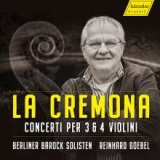Mit ihrem neuen Album entführen uns die Berliner Barock Solisten nach Cremona, einem der wichtigen italienischen Zentren des Geigenbaus und der technischen Entwicklungen im 16./17. Jahrhundert.
Nur allzu gerne bedienten sich Komponisten der vielen Neuerungen, eröffneten sie ihnen doch ungeahnte Möglichkeiten, ihrer Tonkunst zusätzliche Farben, Akzente zu verleihen. Wie unterschiedlich diese ausfallen können, davon gibt diese wunderbare Einspielung einen bleibenden Eindruck.
Für jedes der eingespielten Concerti finden Reinhard Goebel und seine Berliner Barock Solisten genau den richtigen Ton. Indes es bei Durante – etwa im 3. Satz – das tänzerische Element und die feinen Solistendialoge sind, besticht im Leo-Concerto das instinktive Gespür für die Klangarchitektur (2. Satz – Fuga).
Antonio Vivaldi wiederum klingt zupackend, erfrischend quirlig und kontrastreich, während wir den vorwärtsdrängenden Beat im Locatelli-Werk als tragendes rhetorisches Element besonders schätzen.
Hinzu kommt die perfekt gestaltete Räumlichkeit der Aufnahme, die uns als Zuhörer direkt an der Musik teilhaben lässt.
With their new album, the Berlin Baroque Soloists take us to Cremona, one of the important Italian centers of violin making and technical developments in the 16th/17th centuries.
Composers were only too happy to make use of the many innovations, as they opened up unimagined possibilities for them to add additional colors and accents to their musical art. This wonderful recording gives a lasting impression of how different these can be.
Reinhard Goebel and his Berlin Baroque Soloists find exactly the right tone for each of the recorded concerti. While in Durante’s case – for example in the 3rd movement – it is the dancing element and the fine soloist dialogues, in the Leo Concerto the instinctive feeling for the sound architecture is captivating (2nd movement – Fuga).
Antonio Vivaldi, on the other hand, sounds gripping, refreshingly lively and rich in contrast, while we particularly appreciate the propulsive beat in the Locatelli work as a supporting rhetorical element.
Added to this is the perfectly designed spatiality of the recording, which allows us as listeners to participate directly in the music.






















